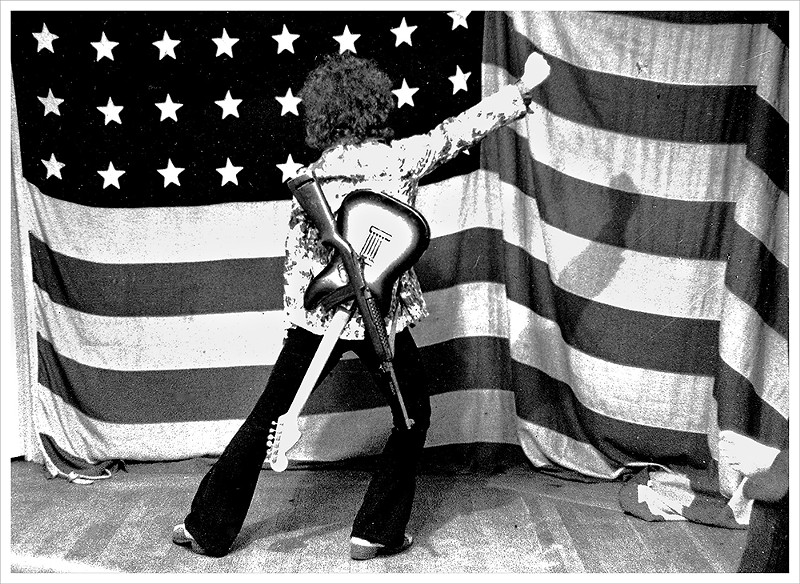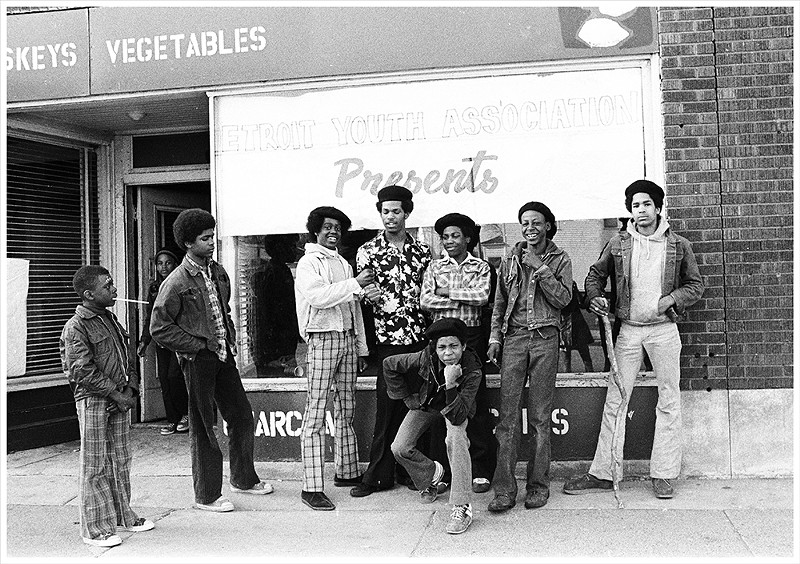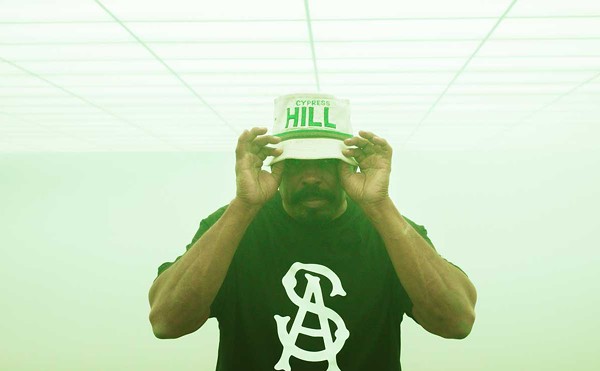It's not a photo of Iggy Pop that is iconic Detroit photographer and activist Leni Sinclair's favorite of her prolific collection, much of which spans more than six decades of American counterculture, revolution, and rock 'n' roll.
Nor is it a capture of Aretha Franklin, Marvin Gaye, Prince, Bob Marley, John Lennon, the MC5, John Coltrane, Jimi Hendrix, Fela Kuti, the Rolling Stones, or ex-husband and marijuana activist John Sinclair, and, actually, none of her images from the 1967 Detroit rebellion, or salutes from the Black Panther Party, or intimate snaps from inside the White Panther Party, which she co-founded, made the cut for her most coveted image, either. In fact, Sinclair's favorite photograph isn't one she has taken but one that defines her journey, legacy, and the badassness she possesses and is far too modest to acknowledge, which makes her all the more badass.
"Well, there's one photograph that I didn't take, but it's one of my favorite photographs of my life," Sinclair says. "And that's me standing at the Berlin Wall with a hammer, knocking it down all by myself. I gave my camera to a bystander and said, 'Could you take this picture of me?' And that's how it happened," she says. "It's my picture, but it's not my photo."
Life moves fast for Sinclair, born Magdalene Arndt, who, at 80, still thinks of herself as an accidental photographer nearly a lifetime after she bought a camera with money given to her by her mother as a going-away gift at just 15, which is when she was preparing her escape from East Germany to, eventually, just three years later, emigrate to Detroit. She says she didn't become an artist until 1964 — when she joined the Detroit Artists Workshop, which she credits for setting her on the creative and philosophical path she still travels down. And despite having an archive of more than 100,000 negatives (or at least that's where she stopped counting), most of which document an eagle's-eye view of life in Detroit in a way that few, if any, have managed to capture, she rarely looks back. She remains firmly rooted in the present, or as she says, "the here and now."
This isn't to say she's not reflective of the past, which, as she insinuates, can give clues as to what the future may hold. She compares the attack on the Capitol as being reminiscent of 1938's Kristallnacht, or the Night of Broken Glass, in which German stormtroopers destroyed thousands of Jewish businesses and places of worship, killing at least 100. And she cites founding father Benjamin Franklin for warning of a future demagogue who would take advantage of the democratic system, just as former President Donald Trump did.

As a lifelong activist who co-founded the anti-racism party the White Panthers, Sinclair participated in historic anti-war protests, civil rights marches, and movements (like the March on Washington and Detroit's Walk to Freedom, as well as its 25th and 50th anniversaries), and as recently as last year documented three Black Lives Matter marches in Detroit. Her photographs speak to a life of someone who has worked tirelessly, and oftentimes, thanklessly, to shift our perspective and to show us the truth. Sinclair's experiences are vast and remain critical in understanding that there is no discernible difference between rock 'n' roll and revolution.
"I got to Detroit in 1959, which was the highest peak of residents," she says. "I think it started going down after I got here — there were two million people here, you know? I lived through the downgrading of Detroit to what it is now. Through the city, you see acres and acres of land where people used to live, children used to play. There were a lot of changes in Detroit, but personally, I didn't really feel the changes. We just did what we did. We did concerts, we made books, we lived at the Grande Ballroom, traveled with the MC5 — it was rock 'n' roll. So we kept going."
After all these years, she still has so much to show — hence, a pair of exhibitions that will display some of Sinclair's lesser-known works as part of the MOCAD's Motor City Underground exhibition and Galerie Camille's group showing Come Together. The shows accompany the release of a long-awaited monograph of Sinclair's work, due out on Foggy Nation Books in collaboration with MOCAD. The concept behind the 408-page book was first spawned over email in 2005, when the late artist Mike Kelley reached out to Sinclair to inquire about putting together an archival publication of her work, at which point he arranged for the late Julie Taubman to borrow Sinclair's hard drive of photographs.
"She took it to L.A. with her and showed it to Mike Kelley," Sinclair recalls. "I had already known about him, and he knew my photography before he moved to L.A. And so he said, 'We should make a book of your photographs and if you're not interested, then fuck you.' That's how he came on right away," she laughs. "That's how it all started. And then his group of people and designers and editors and writers — he had a whole group of people working for him. And they took it upon themselves to get it started. Cary Loren, [Destroy All Monsters] and the proprietor of Book Beat, was like the main instigator to move the project forward."
During the process, though, Kelley died by suicide. But his team, according to Sinclair, wanted to respect Kelley's wishes by continuing work on the book. "But that's when everything changed," Sinclair says.
A convoluted funding process and a newly appointed board of directors made it impossible for Sinclair to move forward with the project, as they wanted to focus on funding work that related to Los Angeles.
"I was left in the cold," she says. I wasn't about to move to Los Angeles to get my book published. This was, to me, kind of a betrayal to Kelley's intentions."
Sinclair’s experiences are vast and remain critical in understanding that there is no discernible difference between rock ’n’ roll and revolution.
tweet this
But in true Sinclair fashion, she teamed up with the late illustrator and artist Gary Grimshaw for a limited run of their co-published, self-funded, and crowdsourced book, Detroit Rocks: A Pictorial History of Motor City Rock and Roll 1965 to 1975. Sinclair says the book was made on a shoestring budget and was denied local artist grant opportunities because Grimshaw's prolific works were regarded as commercial art and Sinclair's work wasn't considered fine art. She also suspects there might be other reasons behind why it was so difficult to seek funding for this and other projects.
"You know, because my name is Sinclair, there is a lot of baggage attached being the ex-wife of John Sinclair," she says. "Somebody may not have liked the name John Sinclar because of his past association with legalizing marijuana."
Ex-husband John, with whom she remains friendly, famously served two years of a 10-year sentence for possession of two joints after a run-in with an undercover police officer in 1969. The incident sparked national protests, including the John Sinclair Freedom Rally in Ann Arbor, where John Lennon and Yoko Ono performed and pleaded for John Sinclair's release. Fifty years later, John Sinclair was among the first to purchase recreational marijuana in 2019, following the legalization of marijuana in Michigan.
"But now everything is different, you know?" she says. "He is one of the heroes of the movement, not that it helps him any or me for that matter, you know because John was in jail while I was outside, changing the law, and at the same time we lived in a commune where there were about 27 kids and my own kids ... we had our hands full trying to get John out of jail."
More than just weed laws and societal stigmas have changed since Sinclair first set out to document the rock 'n' roll rebellion of Detroit and the progressive circles she found herself entrenched in. For instance, the corporatization and restrictions now applied to concert photographers.
"Musicians depend on photographers for their career, and when the bigshot artists came out and said no photographs, I felt it was a smack in the face because did they get famous without photographs?" she asks. " I don't like this new way, you have to sign a contract, you can take pictures, but you can never publish them. I wouldn't have most of my photographs if I hadn't lived long enough already before they instituted all this corporate stuff."
And then there's the rise of the iPhone photographer.
"When Iggy came to play in Detroit at the Masonic Temple or someplace, it was a big deal because he hadn't played there for a long time," she recalls. "And I called up about getting a photo pass and they said, no, no photographs allowed. And so I resigned myself to the balcony in the last row and just enjoyed myself as much as I could. And then I see fans rushing the stage and taking pictures with their phones," she says. "How is that fair to photographers? Now everyone is a photographer with an iPhone."
Imagine denying Leni Sinclair a photo pass. The nerve!
And, of course, a lot has changed in terms of the discovery of music, which is why Sinclair says she doesn't stray far from the 1960s.
"Well, I'm a little old-fashioned," she says. "As it turns out, the best jazz music to me was made in the '60s. The best music in blues was made in the '60s. The best music in rock 'n' roll was made in the '60s. And then many decades later, I discovered rumba from the Congo and found out that the best rumba was made in the '60s, and now the only new things I discover were made 50-60 years ago," she says. "But with YouTube and all the music on there, it's almost overkill. To find the particular LP was such a joy and such a discovery — now you just click on it."
Perhaps one thing that has remained true and untouched for Sinclair is her self-described shyness and her tenacity and desire to be the rock star she never thought she could be — only she's managed to do it from the front row, one eye pressed against a camera, the other scanning the world for another moment to capture. "I so admire people who know how to sing or play an instrument, but I could never be one," she says. "The closest I can get to being one of them is to take their picture."
Motor City Underground presents the Photographs of Leni Sinclair is at MOCAD from Feb. 5 through April 18; 4454 Woodward Ave., Detroit; 313-832-6622; mocadetroit.org. Sinclair's photos are also a part of group exhibition Come Together at Galerie Camille through Feb. 27. 4130 Cass Ave., Unit C, Detroit; 313-874-6737; galeriecamille.com
We have a new events newsletter! Find out the best things to do in the area every Thursday in your inbox.






